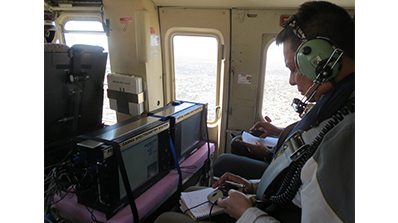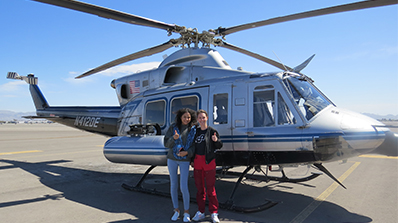Joint surveys at the NNSS help validate data with international allies
In the event of an incident involving an actual or suspected release of radioactive material, the National Nuclear Security Administration’s (NNSA) Aerial Measuring System (AMS), a component of the Nuclear Emergency Support Team, is prepared to deploy and determine ground contamination through airborne radiation detection systems and world-class scientific expertise. But how does a response team validate that data with other nations in the event of a release occurring outside of the United States? Enter AMS joint surveys.
The NNSA AMS team, which operates from the Remote Sensing Laboratory (RSL) at Nellis Air Force Base in Nevada and Joint Base Andrews in Maryland, has partnered with numerous foreign partners – including Israel, Canada, France, Brazil, Mexico, Argentina, the Nordic nations and Taiwan – to compare results of AMS detection operations. Two of the more recent partnerships have occurred in the last two years, with the Government of India Department of Atomic Energy Bhabha Atomic Research Centre and Norwegian Radiation and Nuclear Safety Authority, exercising these comparative aerial measurements at the Nevada National Security Site (NNSS).
Synchronization at the Site
Residual radiation from the nuclear testing in the 1950s and 1960s at the Nevada National Security Site (NNSS) enables a visiting nation to conduct measurements using their technical instruments on NNSA aircraft. Locations at NNSS are selected in order to give scientists the opportunity to test their equipment’s ability to detect and characterize a variety of types and levels of radiological ground contamination. The results are then compared to previously gathered AMS data.

One distinguishing factor for the United States is its dedicated fleet of two Bell 412 helicopters and three newly acquired King Air 350ERs for this public health and safety mission. Most nations use contracted assets, such as police or charter aircraft.
“Because we have our own aircraft and pilots, we’re more practiced with acquiring data,” said Piotr Wasiolek, manager at the NNSS RSL-Nellis. “It’s a tremendous advantage.”
Often scheduled for months or years in advance, joint surveys also allow the comparison of detection equipment that is mounted to the aircraft externally or internally as cargo. In addition to the NNSS, survey locations have included Grand Junction, Colorado, and Government Wash in Nevada’s Lake Mead National Recreation Area.
AMS abroad
Last year AMS scientists traveled to Bodø and Oslo, Norway, as part of a project under the Arctic Council’s Emergency Preparedness, Prevention and Response (EPPR) working group to exchange information and AMS practices with EPPR member states. Given the challenges in responding to a potential radiological release in or near the Arctic, EPPR called upon AMS expertise for a tabletop exercise in the event of a radiological release from a nuclear-powered vessel. During the exercise, AMS assisted the Royal Norwegian Air Force helicopter unit with radiation-detection flights that would be conducted simultaneously with search-and-rescue efforts during a real-life response.
The forum also served as an opportunity for AMS representatives to cover the analysis findings from the joint survey with the Norwegian Radiation and Nuclear Safety Authority.
“One of the strategic goals of the NNSA Office of Nuclear Incident Policy and Cooperation is to advance the United States government’s nuclear-related strategic objectives at home and abroad,” said Wasiolek. “This is done by strengthening and harmonizing global radiological/nuclear incident preparedness and response capabilities,” said Wasiolek.
AMS leaders from around the world will gather in Nevada this spring for the annual International Technical Exchange, an NNSA-sponsored meeting that allows participants to share their developments and capabilities for a chosen AMS topic. This year the technical exchange will focus on the work of AMS teams outside of response situations, including training and exercises, protection of major public events and contamination surveys.
For more information about RSL and AMS, see https://nnss.gov/facilities/remote-sensing-laboratory/.

